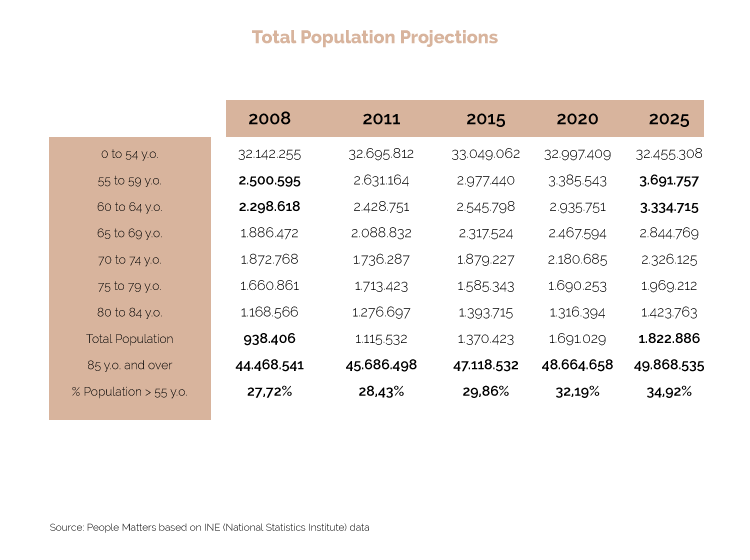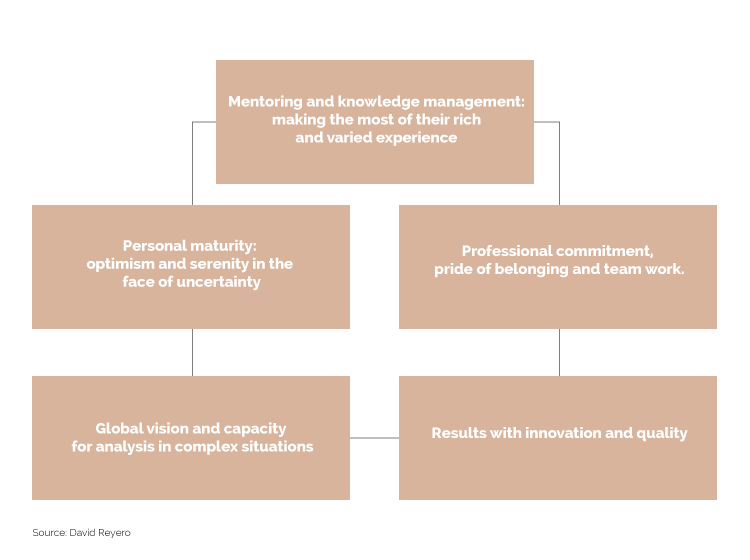«If you are over a certain age (50 or 55 years depending on the cases), you’ll have a big problem to relocate in your company or find another job in the market.»
I have heard this much generalized, maximalist and commonly accepted axiom on many occasions since I began working at the end of the 90s and it has always struck me as being rather inappropriate. So I felt committed to contribute as much as possible to change this.
I was, at that time, motivated by two ideas: my humanistic vision of business management, aimed at providing people with opportunities on the basis of their abilities, and my intuition (rather inexperienced at that particular moment) that this group of professionals could be highly valuable in providing both different and complementary aspects to those offered by younger people. Now, almost twenty years later, I have corroborated this with numerous practical experiences through my relationship with older professionals
This article aims to share a number of thoughts on what is a highly complex issue, which I will address realistically, in the context of business and people, and without resorting to simplistic analysis.
What is the current situation?
There is a double challenge in terms of employability and higher employee talent management as well as the sustainability of pension costs. Here are some facts:
According to studies by People Matters, a consulting firm with extensive experience in demography and labour markets, there are 5 million people aged between 55 and 65 currently living in Spain, with a rate of active employees of approximately 50% (http://ow.lyRP3Xw and table below), in line with the European Union average.

This level of activity has been affected by the economic crisis which has forced many companies to resort, intensely, to early retirement. Cutting down on staff has been the way to ensure the profitability and survival of many businesses in that it tends to be less traumatic and more social and frequently leads to a decrease in average wage expenditure.
According to research by the IESE, early retirement in Spain has been taken by between 60,000 and 70,000 people with an average age of 55, of whom just 40% have returned to work. Complementary information provided by the Social Security indicates that, in the past few years, 44% of senior employees have taken early retirement (http://ow.lyRRZXG).
In combination with this, and due to aging, there are growing budgetary difficulties to finance pensions. In Spain, the percentage of over-65s is expected to double from 2002 to 2050 with an increase of 22% to 44% (See table), which, according to experts, puts the sustainability of the system at risk (http://ow.ly/RP08v).

International reports such as that of the Economist «Is 75 the new 65? (http://ow.lyROUtS)» analyze the need to delay retirement as an inexorable trend in the face of increased life expectancy and the high impact of pension costs on public budgets.”
On the basis of such data, it would seem clear that Western societies must design new HR management policies with regard to older employees and at two levels: collectively (with strategies to prolong work-lives by means of varied and creative formulas and to make pension expenditure sustainable) and in terms of each individual company (by making the most of the capabilities of collectives with a win-win focus and by boosting corporate profitability and personal employability).
Proactive and positive multi-generational management
Although there are still very few cases in the marketplace, a number of companies are already giving some pioneering examples, which indicates that things are changing.
Altadis is promoting the Senior Talent Management program (STM) under the motto «The value of experience» involving five activities in which participants can choose the modality that best suits their preferences: mentoring, knowledge management, multidisciplinary projects, cross knowledge and in-house experts (http://ow.lySN1CI).
Luis Blas, Altadis’s HR Manager explained the philosophy thereof in the programme’s press release: «Talent is ageless: it does not come as a set standard with young people, nor does it fade with age». We want to provide our senior employees with opportunities and, at the same time, make the most of all the existing talent within the company. It is a conscious bid to continue to be one of the best companies to work for in Spain, where the pride of belonging is over 80%.”
Dual Training is another good multi-generational management practice to recover the figure of the senior officer and the apprentice with an up-to-date approach encouraging a mode of Professional Training that is more closely akin to the company. Francisco Belil, Vice President of the Bertelsmann Foundation, is one of its exponents in Spain where this methodology has been adopted in just 2% of cases versus 60% in Central European countries (http://ow.ly/SpUp2).
Elena Cascante has launched generaciona.org, an innovative think tank which, through different initiatives, is evaluating the contribution of over 50 y.o. employees. Its goal is to influence different levels of society to create an active policy of generational diversity in companies that value and properly manage such an important contribution.
Andrés Fontenla, Managing Partner of Fontevalue Consulting, states in his article «Seniors are in fashion» (http://ow.lyROUw5) that the increasingly complex macroeconomic environment is boosting the employment of senior employees and indicates that such a trend is reflected in recent studies such as Adecco’s, showing that 76% of new contracts of employment were generated in the over-45 y.o. collective.
Personal Experiences
In my professional career, I have been fortunate enough to interact with colleagues and have several people who are over 60 in my team who hold positions of responsibility. This has given me great results and is a source of moderation enriched by their experience and personal maturity, a highly valuable asset in difficult times. And I have also participated in a number of successful signings of over 55 y.o. professionals who have made great contributions through their vision and experience which, again, is something particularly difficult to achieve in the context of the marketplace.
I am aware that this positive view cannot be generalized in all cases. The growing demands of the labour market on all professionals have led to cases of senior employees who have either given up hope and lost their enthusiasm to continue working or have not evolved their skills to adapt to the new times, which makes them hard to employ. And there is also pressure to optimize salary expenditure due to the difficulty of maintaining reasonable margins, often affecting the employability of older people, who tend to be costlier than younger generation employees.
However, I believe that a majority of these people can maintain the competitiveness of their profile with appropriate continuous recycling if there is a timely and proactive management of their talent by companies and the necessary self-responsibility and individual effort of employees. This has been my personal experience in such competitive sectors as technology, finance, consulting and pharmaceuticals.
Although currently few companies have this focus I think this is an evident emerging trend. So it is key to design HR policies in training, compensation, working time and transition to retirement that reflected the specificities of these employees.
If we take this approach we will reach two benefits: senior employees will contribute at their maximum level and at the same time their knowledge will remain in the organization increasing the profitability and corporate reputation.
Here is my vision about the key elements of added value from senior employees.

Conclusions
The management of growing diversity in today’s society (age, gender, nationality, experience, opinion…) can be a great competitive advantage for many organizations. We all add to the equation and our strength lies in making good use of such wealth and diversity of experience and focus.
As Enrique Arce wisely states in his book «The Greatest Asset» (http://ow.ly/ROWX8): people management, traditionally focused on middle-aged people and young people with potential, should take measures and develop tools to manage and make the most of a collective which has traditionally been regarded in terms of decreasing contribution.
Therefore, we must act in such a way that our older employees feel integrated in a society to which they have greatly contributed and may continue to do so, although we should not lose sight of the demands of profitability and competitiveness in a globalized world. This is a call for action at all levels (politicians, organizations, trade unions, , and society at large) and a significant leadership from HR departments by means of a special involvement in the management of job opportunities and sensitivity in terms of people, their well-being and their contribution.
To conclude I share two examples of personalities that made significant contributions after 55: Miguel de Cervantes who wrote “El Quijote” at 57 and Winston Churchill who became British Prime Minister at 62.
Article also published at Fundación Factor Humano – November 2015
David Reyero Trapiello – Senior HR Business Partner – Sanofi Iberia
e-mail: David.reyero@sanofi.com / Twitter: @davidreyero73 / Linkedin: es.linkedin.com/in/reyerodavid

Leave a Reply